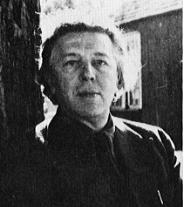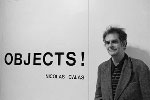|
André Breton and Nicolas Calas, two poets, collaborated on this piece (the
one shown is a reconstruction from a descriptive article). Its simply
construction might have something to do with the fact that the creators weren't
trained artists, or that they were following traditional Dada ideas of using
found object. Its whimsical design, some suggest, relate to Breton's well-known
distaste for Chess.
André Breton
Nicolas Calas



The Christmas Day edition of Newsweek in 1944
described this collaboration -
Cockeyed Chess: On the prankster side, though, is
the concoction of
the surrealist writers Nicolas Calas and André Breton (whose manifesto of 1924
launched the official surrealist movement). These two think chess a useless
foolish game—and narcissistic besides. Their hoard is made up of mirrors so that
the "narcissistic" players can see
themselves, and the chessmen are ordinary drinking glasses of various
sizes and shapes, the "blacks" filled with red wine, the "whites"
with white wine. When a player captures a piece he "must drink the
symbolic blood of the victim." Breton and Calas have also hung a
proclamation on chess called "Profanation" as what they sum up: "The
game should be changed, not the pieces."
|
Profanation
Chess is hand-to-hand combat between two
labyrinths.
An integral weakness of chess is that it does not lend itself to
divination (there is no checkomancy)
The Christian Church has never banned the game of chess, though it did ban
dice and cards.
In order to be a good chess player, One should not be overly intelligent.—
Jean Jacques Rousseau: Diderot did not play very well and readily
acknowledged the superiority of Rousseau, who never failed to heat him.
Modern warfare is an advanced form of chess, hut most of its pieces are
obsolete.
The "queen" in chess is a suspicious character. The ease with which she
moves over the battlefield would have von think that she is a general in
drag.
A woman is too lonely with a chess player. (cf. Marcel Duchamp, Joueurs
d'echecs [Chess Players], 1911.) The real Queen, which we still
await—in chess as elsewhere—is the one foreseen by Barthelemy Prosper
Enfantin, the head of the Saint-Simonian religion (1796—1864).
The only legitimate game is one that would allow, for either player, only
those combinations of moves that have never been attempted before.
Philosophical freedom is an illusion. In chess as in all other games, each
move is loaded with the indefinite past of the universe.
So as to eschew any sense of greatness in competition, one would do) well
to acknowledge being a part of a pyramid of monkey heads.
One element of ancient wisdom we might hold in mind is that deprecatory
voice that the triumphant general in his chariot kept hearing.
Only inspiration is in control, day and night: All in all, not every
calculation is an analysis: a chess player, for instance, does the one ver
well without doing the other.—Baudeiaire
The real Napoleon (the killer) was a mediocre chess player. In Lenin's
tomb on the Red Square, von xviii find a chess hoard (is it the beginning
of a game or one left unfinished?) and fishing floats. On the other hand
(it is only fair to mention it), two great artistic innovators—Marcel
Duchamp, Raymond Roussel—brought new solutions to some chess problems.
The game of chess is not enough of a game; it is too serious an
entertainment .—Montaigne
What must he changed is the game itself, not the pieces |
Nikolaos Kalamarês, born into a wealthy Greek
family in Lausanne, Switzerland in 1907, attended law school in Athens where he
became more interested in literature, politics, art, and cinema and wrote
articles for various magazines and periodicals under the pseudomyn, M.
Spieros. His first poetry collection was published in 1933 under the
pseudonym, Nikêtas Randos. When he moved to Paris in 1937 and became part of
the Surrealist movement, he took on the pseudonym, Nicolas Calas. With
Breton's encouragement he published his first book of essays, Foyers
d’incendie, in 1938. The next year, Calas left for New York as did many
of his group. In the late 1940's, he collaborated with anthropologist
Margaret Mead on a Columbia University project resulting in the publishing
of the co-authored, Primitive Heritage. He also he taught art history
at Fairleigh Dickinson University during the 1960's. Calas died in 1988.
"Art is passionate, it is
made out of love and hatred, of pleasure, of pain; its surprises are
troubling, its comic element is frenetic, its tragic element is cruel,
the blood drips on the scene, we live in an atmosphere of crime,
everywhere we go we are persecuted, as Kafka saw it in The Trial or
Chirico in Hebdomeros. Art frightens, triggers desire, excites sex,
makes our limbs shiver, unsettles the eye, drives the hysterical mad and
gives the madman as an example. Art is never sentimental, never moral,
it is against established order, against the dominant class, against any
conformism, against any priest of any kind and origin. The Parthenon
proves it: Art is a powder magazine!"
|

